{This post is sponsored by Ball® Fresh Preserving}
When fall comes, it’s a good idea to start thinking about herbal remedies that will keep you healthy through winter. This herbal oxymel recipe with sage and ginger is easy to make and has many benefits for the immune system. It also happens to be deliciously sweet and sour!
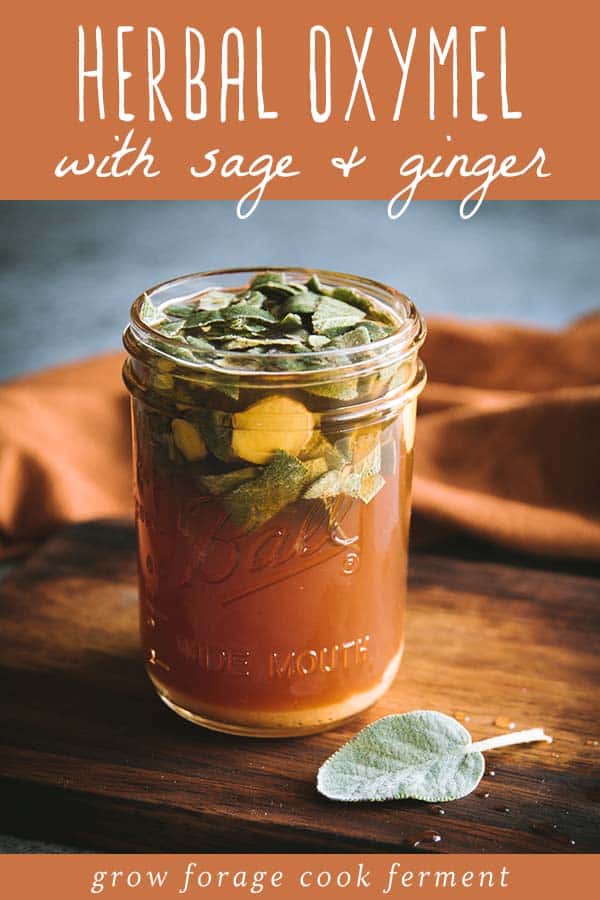
Want to save this post for later?
Ball® Wide Mouth Pint Jars & Leak-Proof Storage Lids
Out of all the Ball® Jars that I have (which is a lot!), I use the Wide Mouth Pint Jars the most frequently, with the Wide Mouth Quart Jars being a close second.
Ball® Wide Mouth Pint Jars are the perfect size for small batch herbal infusions like infused oils, tinctures, and honeys. I make a lot of these herbal remedies, so I always make sure to have these jars on hand!
The Ball® Leak-Proof Storage Lids are great as well, especially for infusions that need to be occasionally turned or shaken to combine. They worked perfectly for this herbal oxymel recipe and there were no leaks!
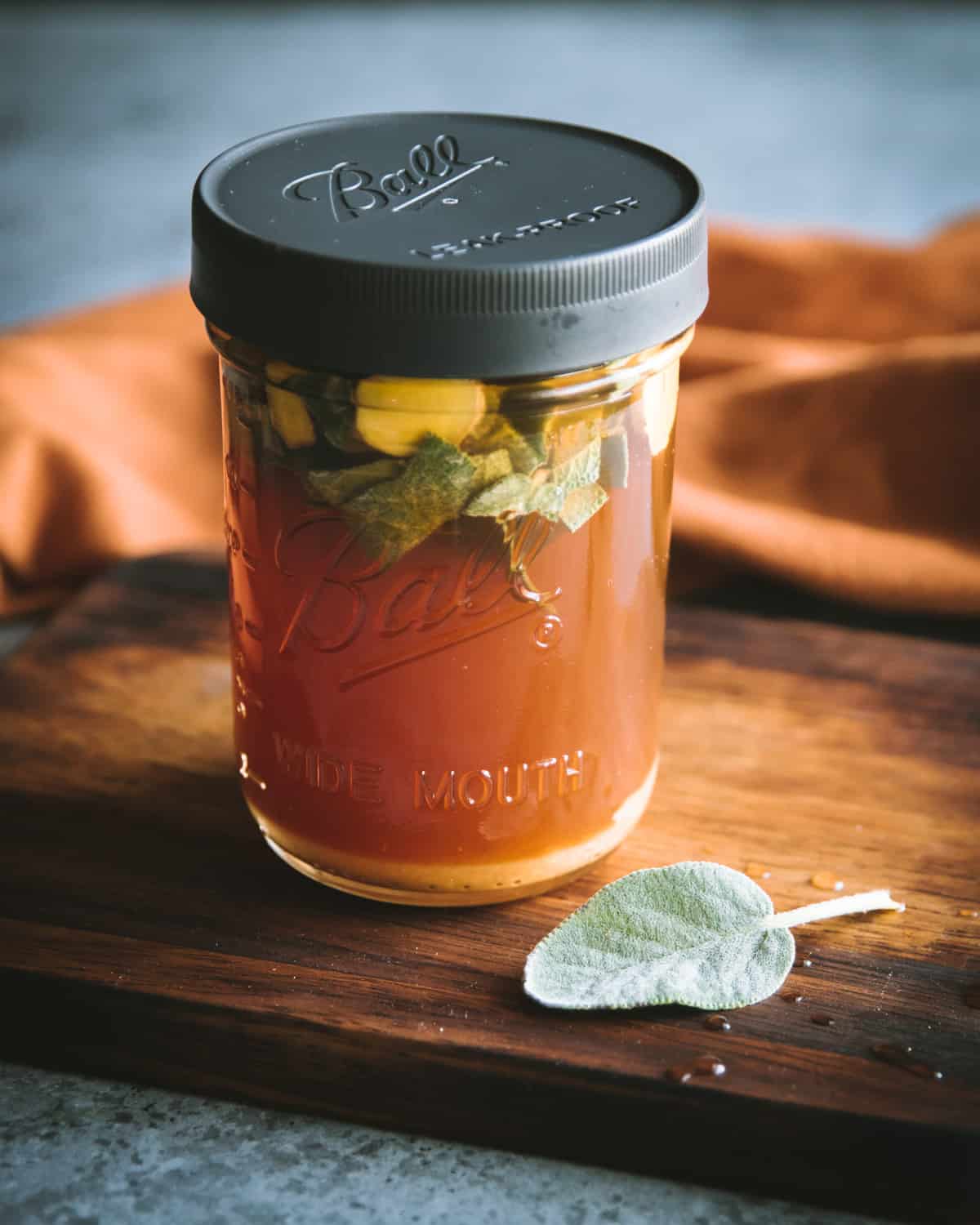
Get more winter wellness recipes for teas, infusions, syrups, honey ferments, oxymels, and gummies in my ebook Herbal Immune Support: Homemade Recipes for Wellness!
What is an Oxymel?
You may be wondering what exactly is an oxymel? Luckily, it sounds a lot more complicated that it is!
An oxymel is an old fashioned herbal remedy that has been around for centuries. In its most basic form it is simply a mixture of honey and vinegar, which are both medicinal in their own right.
The ratio of honey to vinegar can be different based on what your needs are. Traditionally they were made with more honey than vinegar.
Most oxymels today are roughly half raw honey and half raw apple cider vinegar, which creates a delicious sweet and sour taste.
Oxymels are sometimes called an oxymel elixir, and fire cider is actually a type of oxymel.
Herbs to Use in an Oxymel
Most oxymels these days are infused with herbs that will make it even more beneficial. There are many different herbs you can use when making an oxymel.
Many herbs you would use in a tincture could also be used in an oxymel. Some common ones are lemon balm, chamomile, bee balm, mullein, nettles, mint, and dandelion root.
Some great herbs to use in an oxymel for immune support are elderberry, rose hips, echinacea, ginger, garlic, onion, sage, rosemary, thyme, oregano, and cinnamon.
For this recipe, I’m using sage and ginger, which is a combination that I love. Sage is very beneficial for sore throats and coughs, and ginger is a warming immune system stimulant.
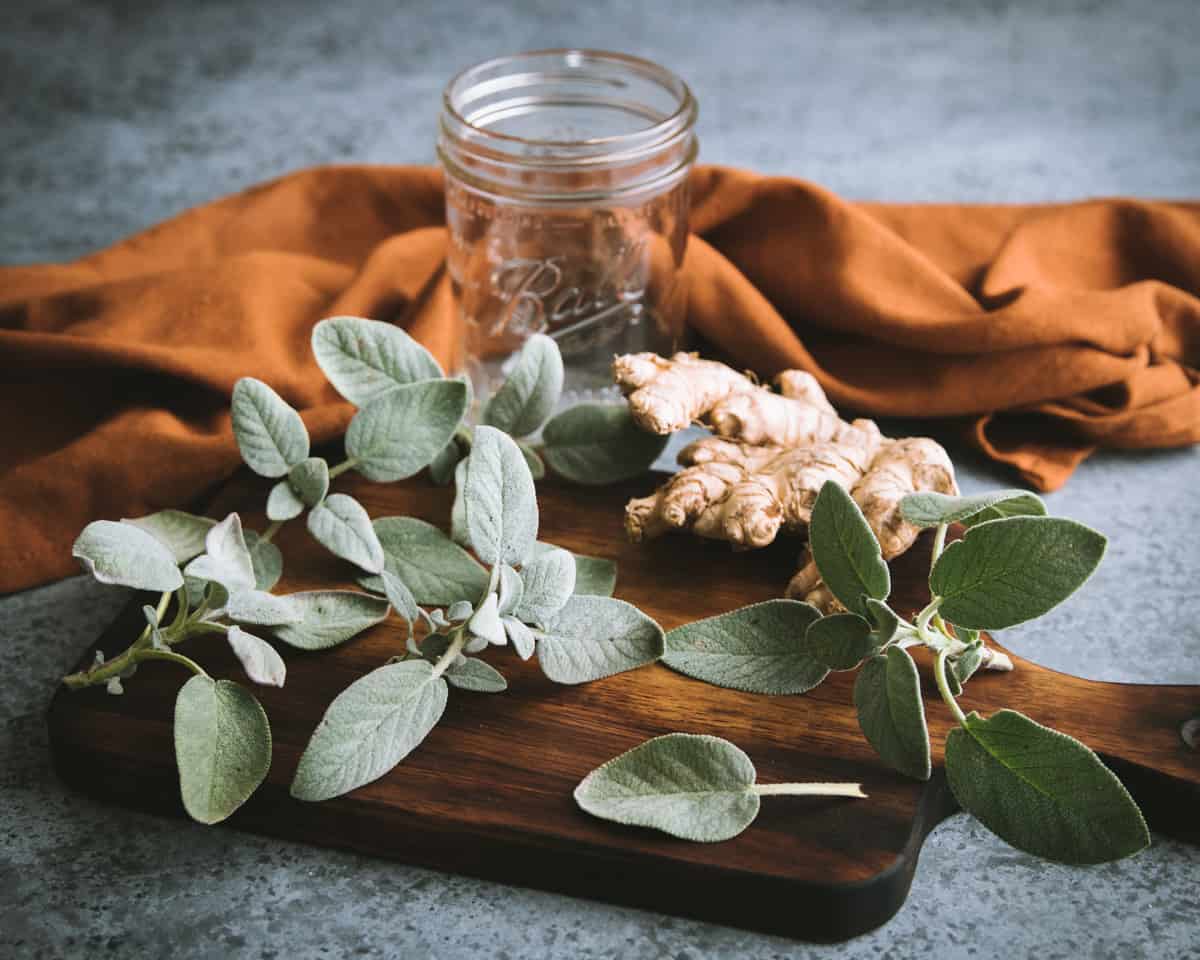
Sage & Ginger Herbal Oxymel Recipe
You won’t believe how easy it is to make this sage and ginger oxymel recipe!
First, put some sliced fresh ginger in a Ball® Wide Mouth Half Pint Jar.
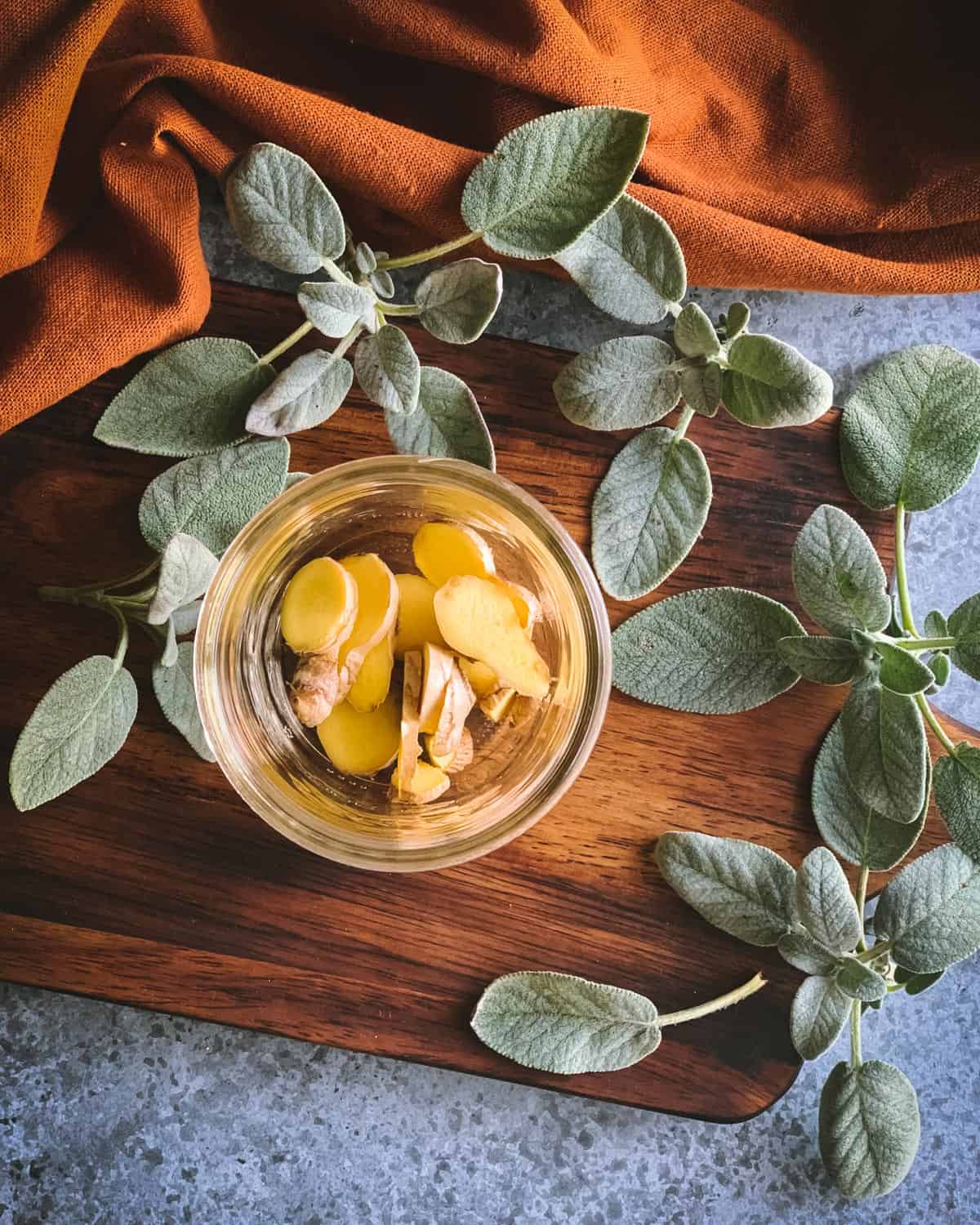
Then chop some fresh sage and add that to the jar with the ginger. You want the jar to be about 1/4 to 1/3 full of herbs.
Next, add some raw apple cider vinegar to the jar. This is where you can customize the amounts a bit based on your taste and preferences. I generally fill the jar about halfway with vinegar.
Then add raw honey to the vinegar and herbs to fill the jar. Don’t worry if the honey is thick, the vinegar will help it to dissolve and combine.
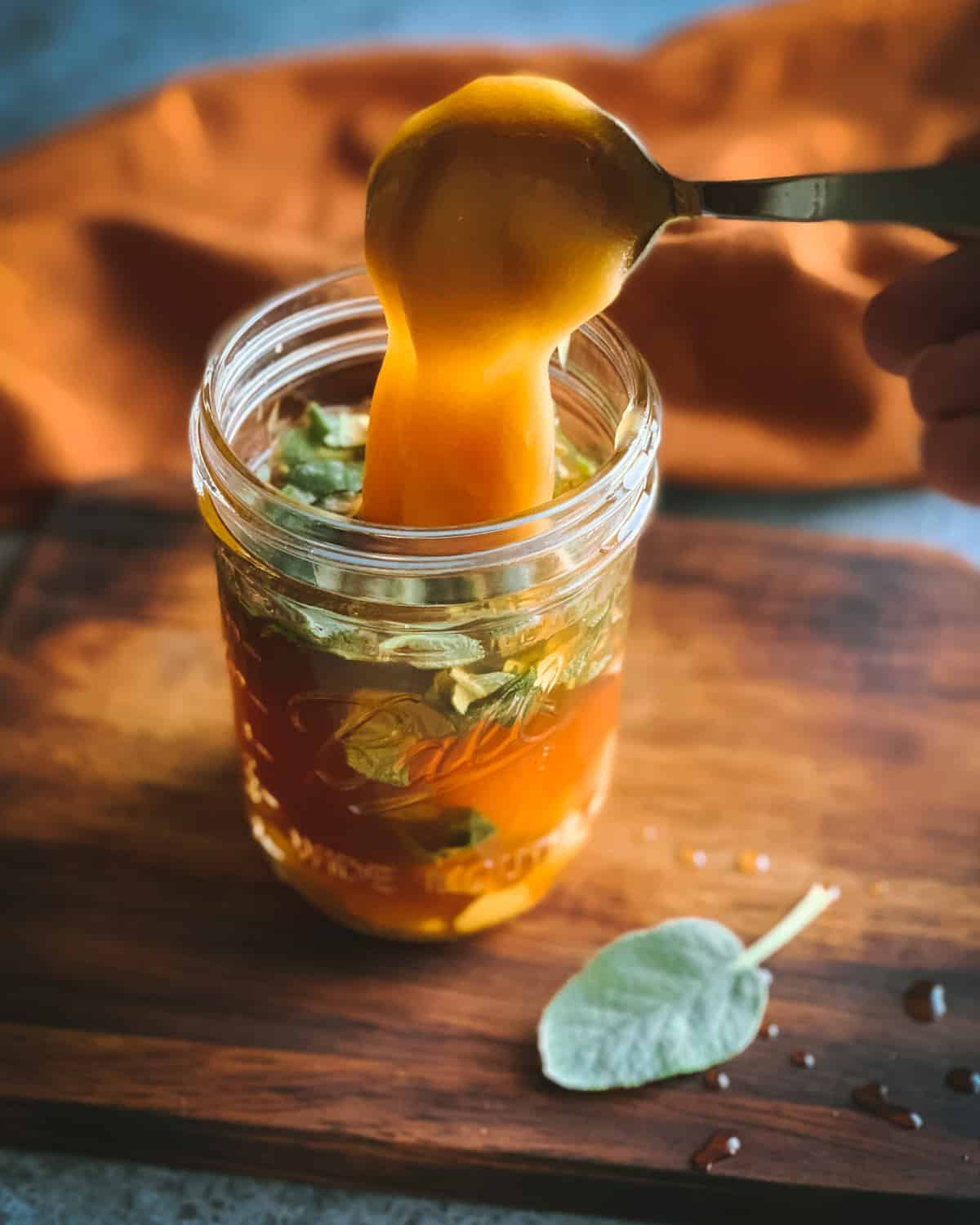
Fill the jar as full as you can without overflowing it, as you don’t want too much airspace on the top. This will prevent oxidation, which can make the herbs turn brown.
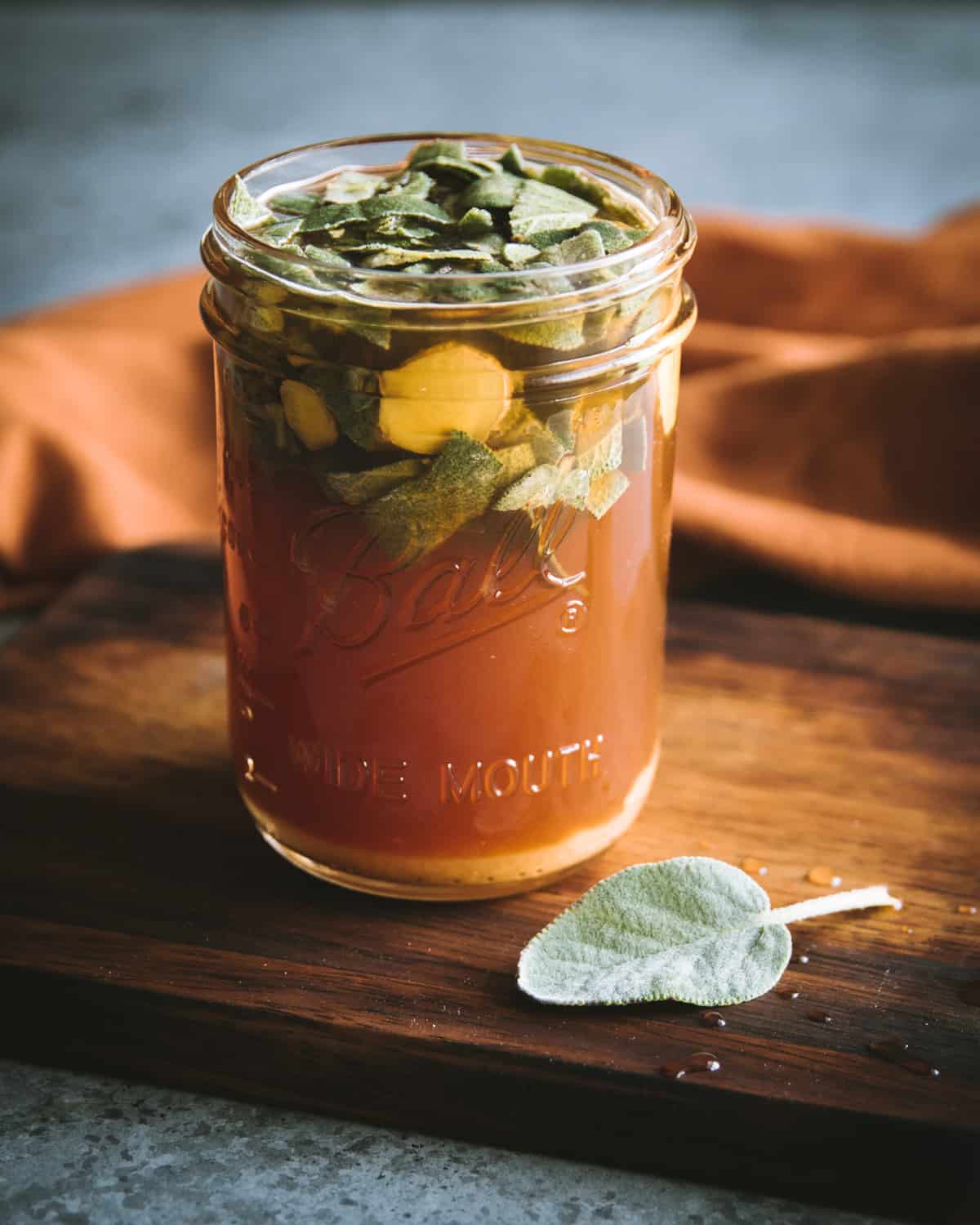
Then wipe the rim, cap the jar with a lid, and give it a few shakes to combine. This is where the Ball® Leak-Proof Storage Lids come in handy!
If you use a metal canning lid be sure to put a piece of parchment paper under it as the vinegar can react to the metal.
Put the oxymel in a cool place out of direct sunlight to infuse for at least a week and up to 30 days. Then strain out the sage and ginger with a fine mesh strainer before using.
Store the strained oxymel in a jar with a lid in a cool place out of direct sunlight. It will keep for 6 months or more. It can also be refrigerated for a longer shelf life.
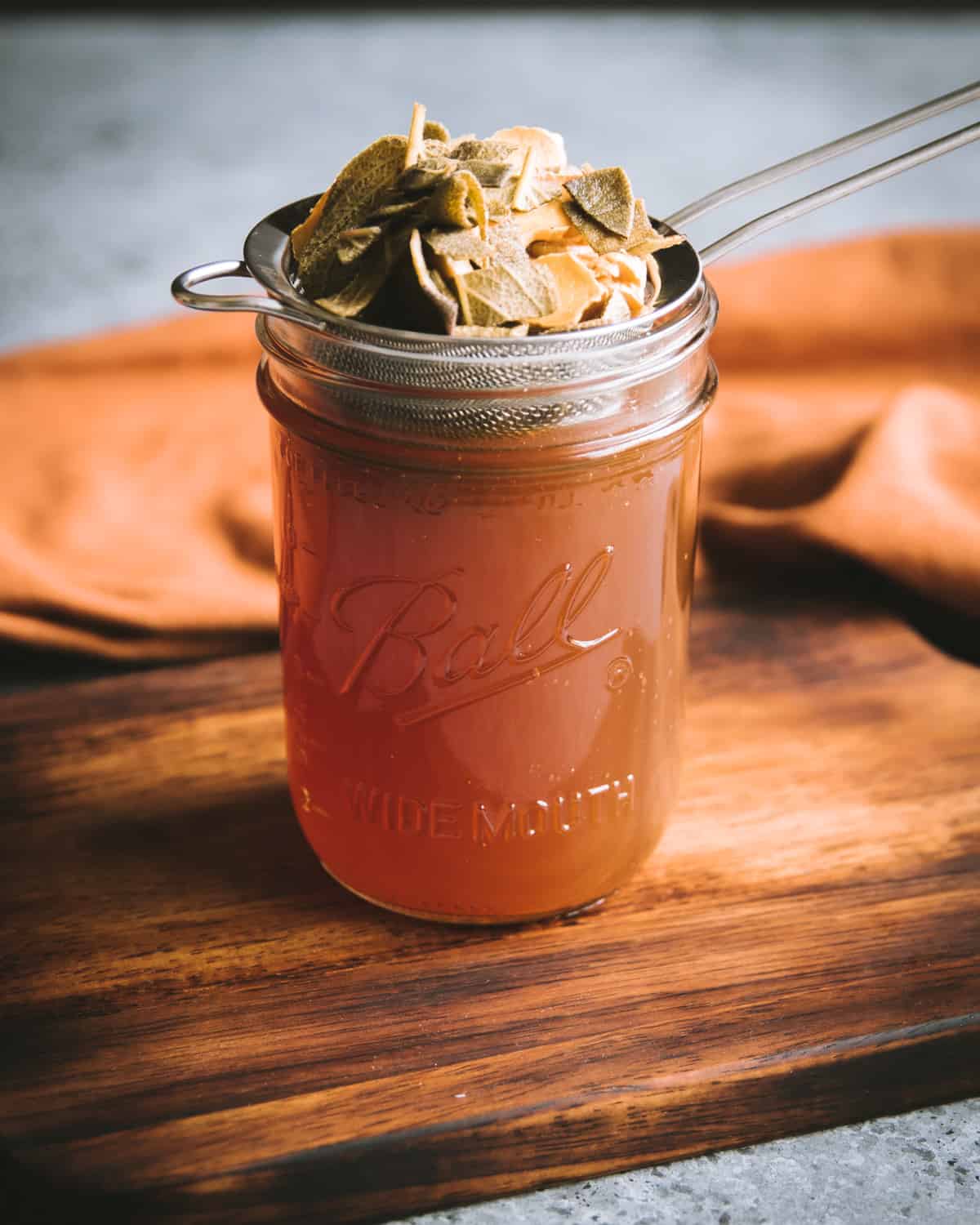
How to Use an Herbal Oxymel
This sage and ginger oxymel can be used in a similar way that you would use elderberry syrup. For adults, take 1-2 tablespoons 2-3 times per day when you feel a sickness coming on.
This oxymel can also be safely taken daily as a preventative. If you use different herbs you will want to do some more research on how often and for what duration of time they can be taken, as all herbs have different properties.
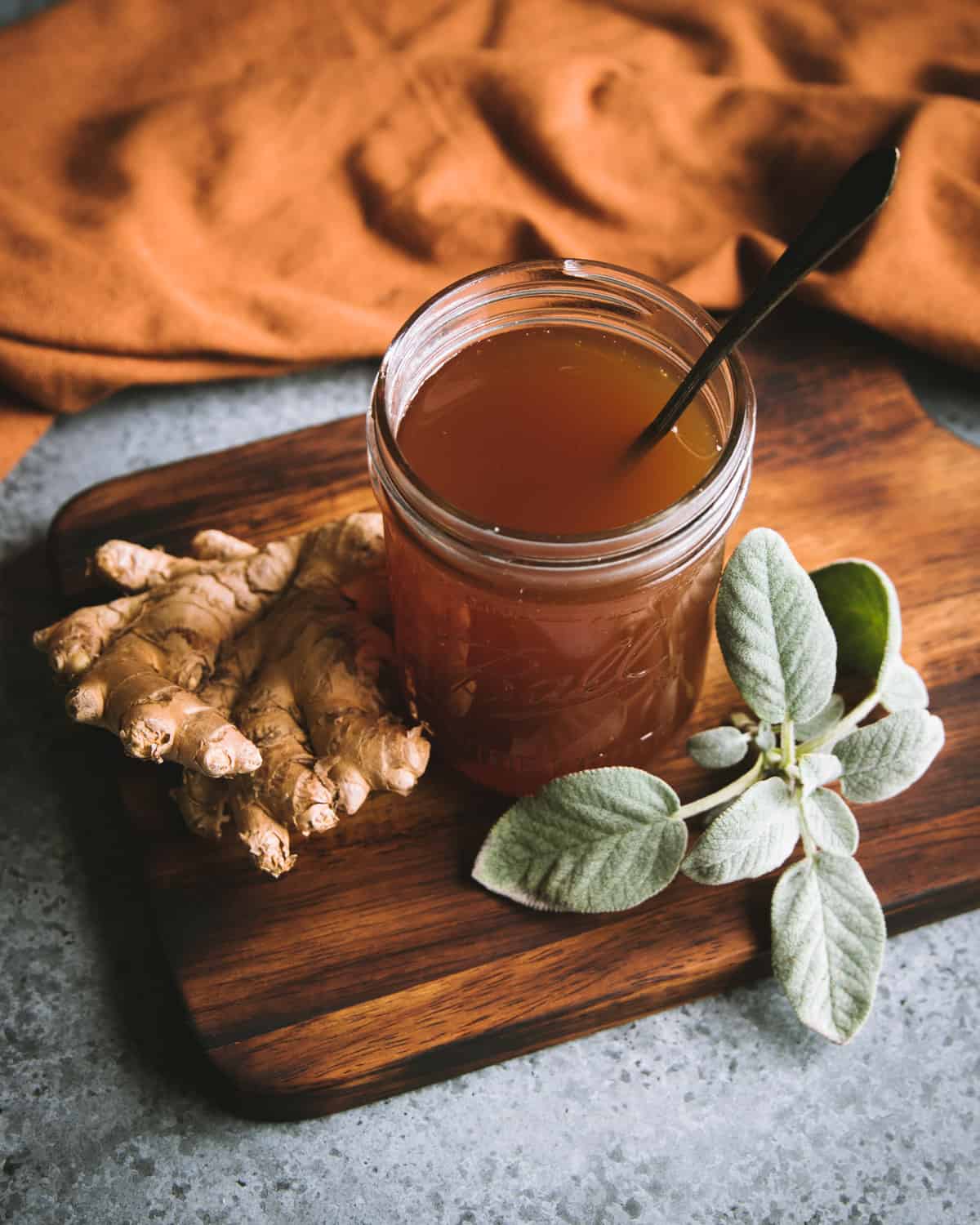
Can Oxymels be Given to Children?
In general, oxymels can be given to children over the age of one, but be sure that you are using herbs that are safe for children. You may also want to use a higher proportion of raw honey, as the vinegar taste can sometimes be too much for kids.
This sage and ginger oxymel is safe for children, just use a smaller dosage based on their size.
Oxymels should not be given to children under the age of one due to the raw honey.
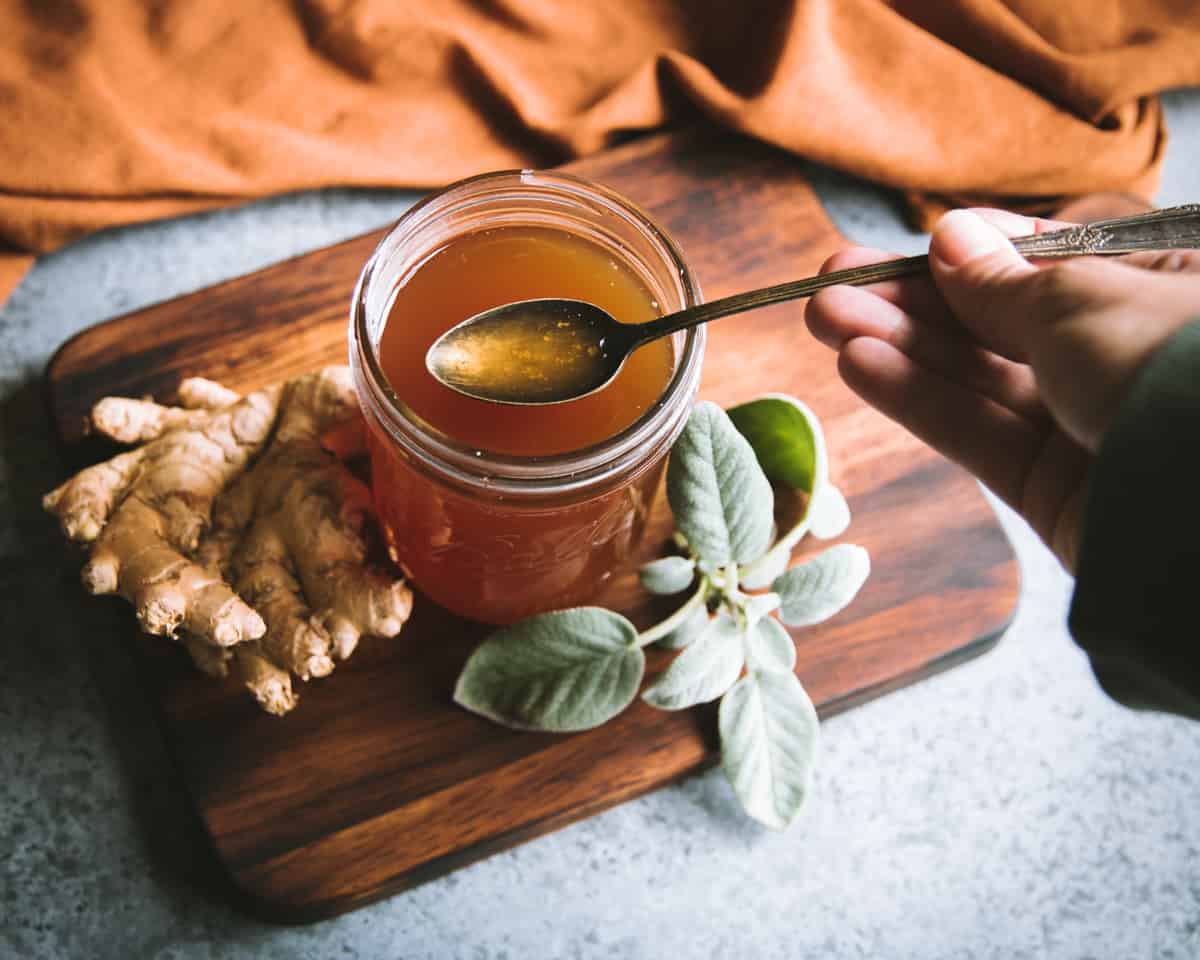
Herbal oxymels are simple and fun to make and are really good for your health. I highly recommend giving this old fashioned herbal remedy a try!
More Immune Boosting Herbal Remedies
Boost your immune system with these herbal remedies!
- Elderberry Syrup
- Fire Cider
- Fermented Honey Garlic
- Aronia Berry Oxymel
- Self-Heal Oxymel
- Manuka Honey Vinegar Elixir
- Immune Boosting Herbal Tea
- Elderberry & Echinacea Tincture
Herbal Oxymel with Sage and Ginger
Equipment
- Ball® Wide Mouth Pint Jar
Ingredients
- 2" piece fresh ginger sliced
- 1/2 cup fresh sage leaves roughly chopped
- 1 cup raw honey
- 1 cup raw apple cider vinegar
Instructions
- Put the sliced ginger and chopped sage into a wide mouth pint jar. The jar should be about 1/4 to 1/3 full of herbs.
- Fill the jar about halfway with raw apple cider vinegar, more or less depending on your preference.
- Add raw honey to the vinegar and herbs to fill the jar. Don't worry if the honey is thick, the vinegar will help it to dissolve and combine.
- Wipe the jar rim, cap the jar with a lid, and give it a few shakes to combine.
- Put the oxymel in a cool place out of direct sunlight to infuse for at least a week and up to 30 days. Then strain out the sage and ginger with a fine mesh strainer before using.
- Store the strained oxymel in a jar with a lid in a cool place out of direct sunlight. It will keep for 6 months or more. It can also be refrigerated for a longer shelf life.
Notes
- Fill the jar as full as you can without overflowing it, as you don’t want too much airspace at the top. This will prevent oxidation, which can make the herbs turn brown.
- If you use a metal canning lid be sure to put a piece of parchment paper under it as the vinegar can react to the metal.
- For adults, take 1-2 tablespoons 2-3 times per day when you feel a sickness coming on.
- This sage and ginger oxymel is safe for children over the age of one, just use a smaller dosage based on their size.
- Oxymels should not be given to children under the age of one due to the raw honey.


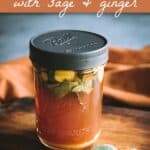
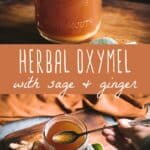
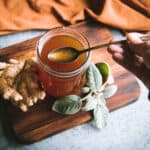

Hello,
I started a Sage and self heal oxymel using a combination of your recipes last September 22nd. Due to giving birth to twins and then life being insane, I never strained it. It’s not moldy at all. Would this be safe to strain and use after this long?
Yes, totally fine!
Can I use this to put into an herbal mocktail with ice? Or will that kill off any of the benefits? Thank you!
Yes, that’s totally fine. Enjoy!
Thank YOU! I’ve been making herbal mixes lately, but haven’t figured out how to have them best to apply. I didn’t want the messy of capsules, yet no one wants to eat raw herbs either. This way allows for good use. You’ve provided the solution for me!
You’re so welcome, April. Enjoy!
What is the least amount of vinegar I can use in this recipe and it still be shelf stable? I get heartburn very easy from acidic foods.
You can use as little as you need to or none at all. Simply infuse the herbs into the honey, if you prefer.
Oooh thanks for sharing! Definitely going to try this! Love herbal recipes 🌿
Hello! Do you use ACV with the mother or without? I plan on making this today!
With the mother.
I made mine in November and I did not remember to strain out the sage and ginger do you think it’s still OK?it’s been in a cool place in a dark place? i guess i am saying is a vital to strain out the sage and ginger?
kindly,
joelle
Hi Joelle. As long as it’s not moldy, it should be totally fine.
What type of sage did you use here?
Great site. I tried without luck to submit my name/email for the online program.
Hi Brenda. I believe you are signed up for the email course, so let me know if you received the welcome email!
Hey, what can I use instead of honey?
Thanks!
You can use maple syrup or any other thick liquid sweetener, but it won’t be as medicinally beneficial as if you were to use raw honey.
Thank you for the alternatives. My daughter cannot have honey (or agave), but so many remedies use it (I get why, it’s awesome!) but it’s sometimes frustrating dealing with dietary restrictions! Many times people just say there’s no alternatives.
As a note, if maple syrup is used it should definitely be stored in the fridge as maple syrup does not have the same preserving qualities as honey.
Hi there,
I recently have been making oxymels from the recipe I found on your website.
There is a note about using a plastic lid. I didn’t do this, instead I put some baking paper between the jar and the preserving can style lid. It seemed I used the wrong kind of paper as it seeped through and when I checked the jars I noticed there was some black stuff that smelt a bit rusty on just the edge of a very full jar, so the liquid was definitely touching it.
I’m wondering if you can offer me advice as to whether or not my brew was contaminated.
Do I throw this batch out?
I so appreciate you taking the time to read and respond!
Thanks,
Tegan Rose
Hi Tegan! Sorry to hear about your oxymel. It’s really hard for me to say whether or not it’s contaminated or not. Use your best judgement. Personally, I probably wouldn’t use it.
Can i use mint leaves instead of sage.
Definitely!
I just made this oxymel. Can this be added to an herbal tea or will the hot water ruin the health benefits? I also am trying your fermented garlic and honey. Took only 1 day and it is nice and bubbly!
Adding your oxymel to hot tea (above 90 degrees Fahrenheit) will kill off the good enzyme content of your raw honey. My recipe for herbal popsicles would be a great alternative. Simply stir in the oxymel after the tea has cooled. Enjoy!
I just made this today, can’t wait to try it. While I did make it with fresh ginger, can I use frozen ginger after it’s been defrosted? I usually freeze my ginger to store. Thanks.
Yes, that should still work.
If you wish to use this as a preventative, do you take the same recommended dose (1-2 Tablespoons 2-3 times a day) as you would when you feel a sickness coming on? I grew quite a bit of sage this year and we should have a frost soon. Looking for ways to use my sage fresh. Have a whole lot drying too. I am really enjoyning your gather + root foraging course, also.
Hi Katherine! Yes, you can take the same recommended dosage or more, if you wish. I’m glad you’re enjoying the gather + root foraging course too! ☺
hello, thank you for this wonderful recipe. could dried herbs be used in place of fresh ones?
warm wishes
karin
Hi Karin! Yes, you can use dried herbs. Because they’re more potent, I would use less than my recipe suggests.
Thanks, Colleen. This one sounds great and easy too.
You’re welcome! ☺
I do not have fresh sage. Can one use dried sage instead?
Yes, but you’ll want to use a bit less since dried herbs have a more concentrated flavor.
Can this be made with dries sage?
Yes, but you’ll want to use a bit less since dried herbs have a more concentrated flavor.